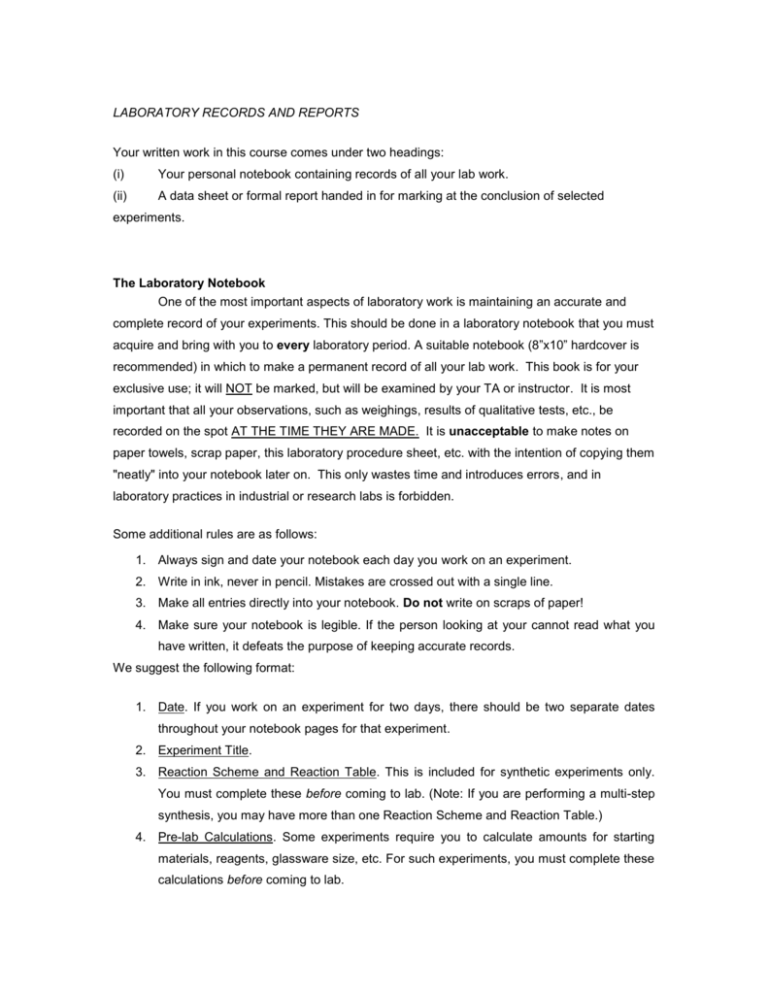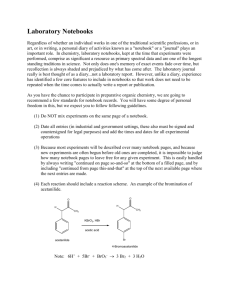LABORATORY RECORDS and reports
advertisement

LABORATORY RECORDS AND REPORTS Your written work in this course comes under two headings: (i) Your personal notebook containing records of all your lab work. (ii) A data sheet or formal report handed in for marking at the conclusion of selected experiments. The Laboratory Notebook One of the most important aspects of laboratory work is maintaining an accurate and complete record of your experiments. This should be done in a laboratory notebook that you must acquire and bring with you to every laboratory period. A suitable notebook (8”x10” hardcover is recommended) in which to make a permanent record of all your lab work. This book is for your exclusive use; it will NOT be marked, but will be examined by your TA or instructor. It is most important that all your observations, such as weighings, results of qualitative tests, etc., be recorded on the spot AT THE TIME THEY ARE MADE. It is unacceptable to make notes on paper towels, scrap paper, this laboratory procedure sheet, etc. with the intention of copying them "neatly" into your notebook later on. This only wastes time and introduces errors, and in laboratory practices in industrial or research labs is forbidden. Some additional rules are as follows: 1. Always sign and date your notebook each day you work on an experiment. 2. Write in ink, never in pencil. Mistakes are crossed out with a single line. 3. Make all entries directly into your notebook. Do not write on scraps of paper! 4. Make sure your notebook is legible. If the person looking at your cannot read what you have written, it defeats the purpose of keeping accurate records. We suggest the following format: 1. Date. If you work on an experiment for two days, there should be two separate dates throughout your notebook pages for that experiment. 2. Experiment Title. 3. Reaction Scheme and Reaction Table. This is included for synthetic experiments only. You must complete these before coming to lab. (Note: If you are performing a multi-step synthesis, you may have more than one Reaction Scheme and Reaction Table.) 4. Pre-lab Calculations. Some experiments require you to calculate amounts for starting materials, reagents, glassware size, etc. For such experiments, you must complete these calculations before coming to lab. 5. References. A list of the reference materials used for the experiment. The source for anything you look up to help you with the experiment becomes a reference. 6. Chemical List. A list of all chemicals (including pertinent data) used. If you have not used the chemical previously, you must draw the chemical structure. For synthetic experiments, the Chemical List is augmented by a reaction table. 7. Apparatus. A list of all equipment to be used for the experiment. All instrumentation used is also listed here (instrument model number and, if applicable, instrument parameters). 8. Procedure. A description of experimental manipulations performed in the experiment (be specific enough that someone can repeat the experiment without the aid of any other information). Include detailed operational procedures for any specialty equipment or instrumentation used. This should be what you actually did in lab, not a “copy” of the experimental procedure from the source (your laboratory experiment handout). This can be point form. You also record any observations here. For example: “On addition the solution turned a cloudy color”. 9. Data/Data Analysis/Calculations. Calculations include data for graphs, area calculations, calculations for spectroscopic analysis, and reaction yields. Data includes a list of all data, including observations, recorded during the experiment. Some of this information may need to be “gleaned” from other sections (especially the procedure section) and rewritten here. Rough notes on spectral assignments. This Notebook is used to prepare formal reports. Obviously, if your notebook is beside you on the bench all the time, it will acquire water stains on the cover and dog-eared corners to the pages. Don't worry about it; this is a working laboratory, not a museum! At the same time, try to keep your records neat and legible for future use. Students often fear that they may write in the notebook something which later turns out to be "wrong". Again, don't worry, just cross it out (neatly, by drawing one line through it, don't waste time with erasers or "liquid paper") and write in the correction. Be especially careful to record data given to you in the lab. On many occasions you will be given "unknowns" to investigate. These will have code numbers for identification, which you should record immediately when you receive them. We suggest that you use the right-hand page only for recording observations. Later on, you will start roughing out equations, calculating yields, working up analytical results, etc., and this may conveniently be done on the left-hand page opposite the original data. All results will then be coordinated when you come to prepare your Data Sheets or write your Formal Report. Data Sheets Some experiments will not require a formal report only completion of Data Sheets. Formal Reports Experiments without Data Sheets will be reported using formal reports. A suggested format for these reports is as follows: (maximum of 5 pages, excluding attached spectra) The principal sub-sections should include: INTRODUCTION – a brief statement of purpose and/or general objectives 1. 2. REACTION EQUATION (S) a full equation of reactants/products - but not a mechanism which appears in the Discussion. It is appropriate (and encouraged) to include data on properties e.g., B.P., M.P., Density; M.W.; Weights used (g and mmol) Solvent A + B C + D Temp., Cat MW of A Wt used mmol 3. MW of B Wt used mmol MW of C Wt expected mmol MW of D Wt expected mmol PROCEDURE A brief outline of what you did: Reaction; isolation; purification; or cite this lab manual. where appropriate, "Flow Charts" of, for example, complicated extractions, separations Comment if, how and why your procedure differed from that in the manual. 4. RESULTS Give for each product isolated: Yield – In weight and percent (show calculation) – always for the pure product; sometimes (where appropriate) crude yield will also be required Tables of Results of qualitative tests Physical Properties -Appearance (liquid/solid, crystalline character, color) -bp., mp., CITE LITERATURE VALUE FOR COMPARISON -Spectra with peaks labeled -Results of any tests 5. DISCUSSION OF RESULTS: This will depend on particular case, but may include: Evidence that correct product was obtained (mp, bp, spectra) Nature of reaction (role of reagents; conditions (temp., etc.)) Yield; explanation of high/low; side reactions "Special Features": e.g., extraction; chromatography; spectra; stereochemistry; Mechanism: One general mechanism with curly arrows will suffice.










